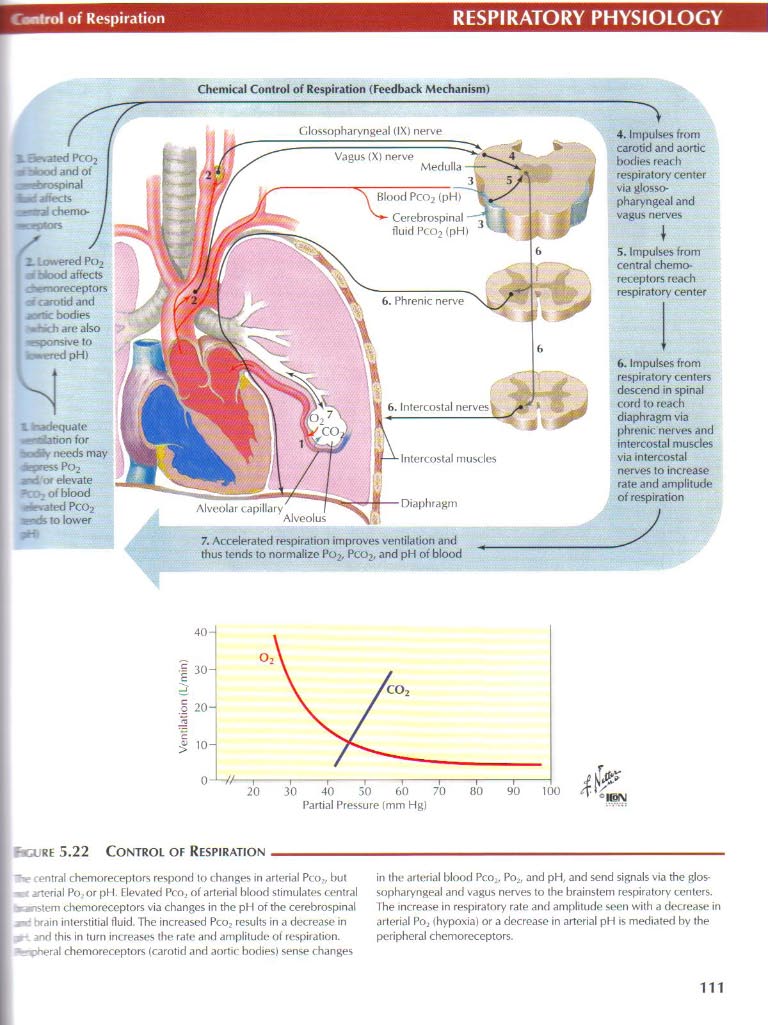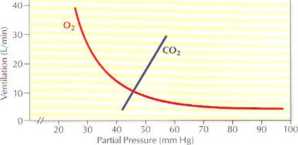77586 netter96

Mitrol of Respiralion
RESPIRATORY PHYSIOLOGY
Chemical Control of Respiration (Fcedback Mcchanism)
Cilossopharyngeal (IX) nerve
Vagus|X)nerve
2. ^owered Po2
m biood affects ^emoreceptors a carotid and aortic bodies h arc also
■«f5ponsive to c^Mrred pH)
l hadequate —-aiation for
needs may *pressPo2 and or ełevate of biood . ated PC02 **ads to lower pH>
Alveolar capillary
Diaphragm
7. Accelerated respiration improves ventilation and thus tends to normałize Po2, Pco2, and pH ot blood

4. Impulses from carotid and aortic bodies reach respiratory center via glosso-pharyngeal and vagus nerves
*
5. Impulses from central chemo receptors reach respiratory center
6. Impulses from respiratory centers descend in spinał cord lo reach diaphragm via phrenic nerves and intercostal musełes via intercostal nerves to inerease ratę and amplitudę of respiration

rcuRE 5.22 Control of Respiration-
"V en trał chemoreceptors respond to changes in arterial Pco„ but -*-r artcrial Po., or pi 1. Flevated Pro., of arterial blood stimulates central * anstem chemoreceptors via changes in the pH of the cerebrospinal r>r twain inlerstitial fluid. The incrcased Pco2 results in a decrease in and this in lurn intreases iłu* ratę and amplitudę of respiration. ^-Tiberal chemoreceptors (carotid and aortic bodies) sense changes in the arterial blood Pro.. Po... and pH, and send signals via the glos-sopharyngeal and vagus nerves to the brainstem respiratory centers. Ihe inerease in respiratory ratę and amplitudę seen with a decrease in arterial Po, <hvpoxiai or a decrease in arterial pH is mediated by the pcripheral chemoreceptors.
111
Wyszukiwarka
Podobne podstrony:
netter82 Nłedianics of Respiration: Elastic Properties IRESPIRATORY PHYSIOLOGY During a slow expirat
netter84 tlechanics of Respiration: Surface ForcesRESPIRATORY PHYSIOLOGY Pressure (cm HjO) alveoli i
80805 netter84 tlechanics of Respiration: Surface ForcesRESPIRATORY PHYSIOLOGY Pressure (cm HjO) alv
netter84 tlechanics of Respiration: Surface ForcesRESPIRATORY PHYSIOLOGY Pressure (cm HjO) alveoli i
netter109 Renal Clearance: IIRENAL PHYSIOLOGY PRINCIPIE OF TUBULAR SECRETION LIMITATION (Tm) USINC P
netter135 Gastric Secretion: IGASTROINTESTINAL PHYSIOLOGY Neurocrine Regulalion of Acid
netter136 Gaslric Secretion: IIGASTROINTESTINAL PHYSIOLOGY Secrelions of gastric acid (H* ) by parie
netter161 Overview of Hormone ActionENDOCRINE PHYSIOLOGY Steroid Hnrmones Thyroid Hormones Vita
netter162 Regulatinn of Hormone Secretion ENDOCRINE PHYSIOLOGY Negative Fccdback Hypolhalamus V Targ
netter180 Actions of InsulinENDOCRINE PHYSIOLOGY Figurę 8.20 Actions of Insulin- Insulin is a fueł-s
netter190 Whcn words alone won t do, think NetterNetter s Atlas of Humań PhysiologyJohn T. Hansen, P
netter49 I I Cardiac Mustlt*: StructureMUSCLE PHYSIOLOGYFlCURF 3.7 SCHEMA OF STRUCFURt OF CARDIAC MU
netter52 Fxcitation-Conlraclion CouplingMUSCLE PHYSIOLOGY HART 3.1 COMPARISION OF MUSCLE STRUCTURE A
netter55 Slructure of the HeartCARDIOYASCULAR PHYSIOLOGY Mitral valve Poslerior cusp- Ascending aort
netter70 Monitoring of Blond PressureCARDIOVASCULAR PHYSIOLOGY Low-Pressure Baroreceptors ANP releas
16523 netter73 Rrsponse to txeras»CARDIOVASCULAR PHYSIOLOGY Anticipation of exercise stimulates
więcej podobnych podstron